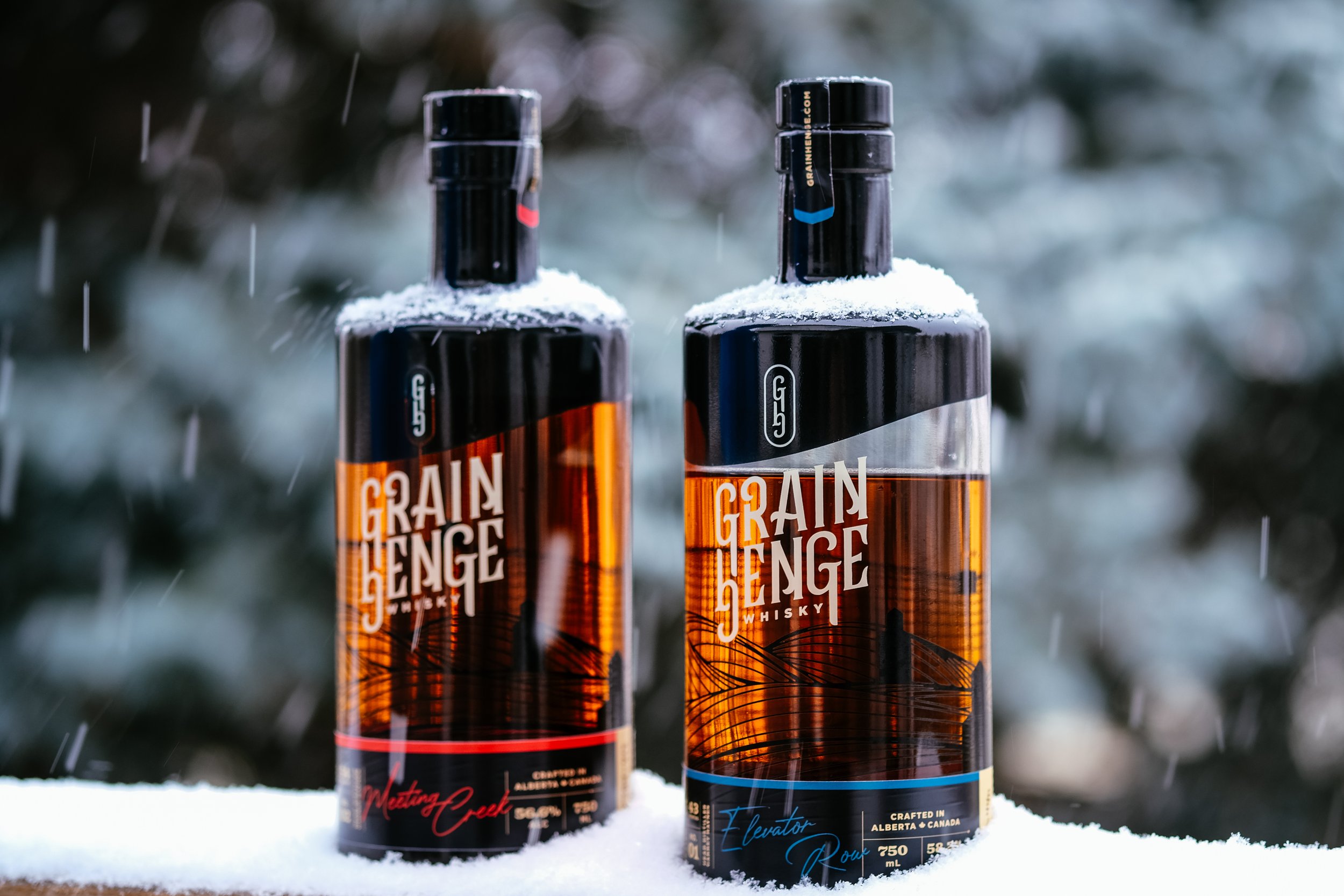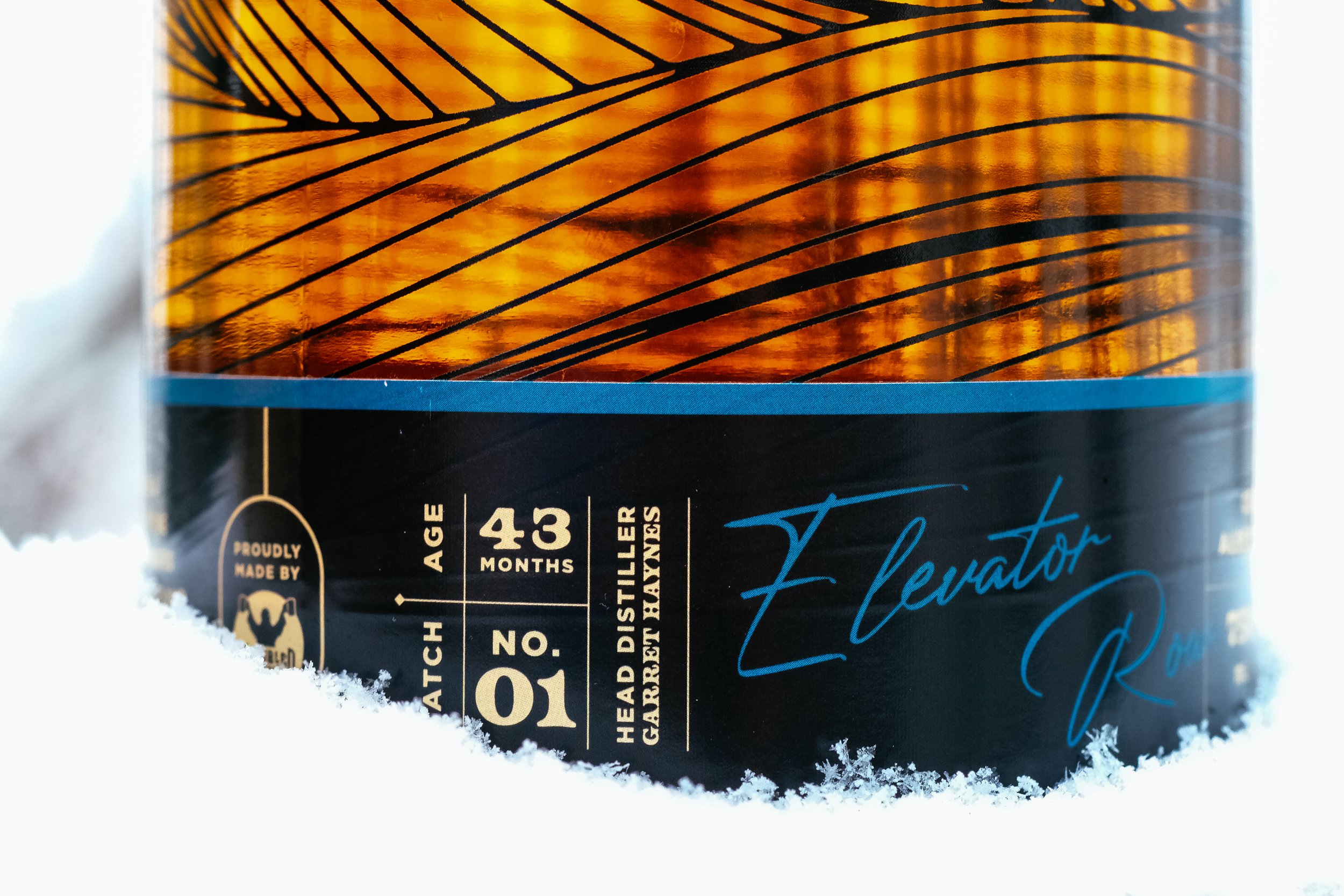Grain Henge Canadian Single Malts
Elevator Row & Meeting Creek | 58.2% & 56.6% ABV
Score: 6/10
Good stuff.
TL;DR
Real Canadian flexibility versus a scotch-alike approach
Identity Crisis for Canadian Single Malts?
As Canadian’s, we are generally a melting pot of various cultures and influences. We take pride in our diversity and welcoming nature, embracing your unique culture and preferences when you immigrate to our very large footprint but small(ish) population shores and prairies.
While there are exceptions to this rule, it’s a general rule that still holds true to this day despite the onslaught of very minority fringe groups that abuse the privilege of social media’s far reaching and potentially damaging megaphone.
Generally speaking, we had a significant influx of UK-folk (Scottish and Irish) and Eastern European (Ukrainian and Polish) in the first half of the 20th century, with very regional concentrations of French, German, and Dutch/Norwegian pockets scattered throughout our landscape and primarily were focussed on our large agriculture industry.
This meant that they brought their distilling knowledge and combined it with the crops that would actually grow in our more challenging climates. Traditionally, this meant a large portion of our whisky was made from hardy rye and wheat, with barley following in third place. The advent of better crops and agricultural methods meant that we could grow world-class barley in our shorter growing seasons. And alongside these advancements was the growing influence of our large southern neighbour with their predilection towards all things sweet (bourbon) on our whisky exports.
Canada produces a very significant portion of the global whisky volumes, with the vast majority being exported for cocktails around the world so it makes sense that we would be catering to various markets. But what about our more local and “craft” based distilleries? How does this melting pot society impact our local whisky?
Well, to be honest, we’ve yet to decide on a singular identity for our whisky. But don’t get me wrong, I’m not complaining here. Variety is the spice of life and we’ve got plenty of variation in the single malt scene.
Distilleries such as Glenora and Macaloney’s are taking a more Scottish approach to their single malts, even earning the ire of the Scotch Whisky Association’s legal team. Glenora (under the Glen Breton brand) was the OG single malt distillery in Canada (circa 1990) and even the USA, and given their location in Nova Scotia (ie. direct translation is New Scotland), began creating solely ex-bourbon (primarily Jack Daniel’s) single malts with unpeated and Canadian peated malt. I’ve yet to try any of their spirits given their price point that previously seemed excessive however recent price hikes have levelled that playground. Perhaps it’s time to turn my focus towards this long-standing Canadian icon.
Ironworks, also in Nova Scotia, uses new French oak and Hungarian oak to introduce spice and colour into their well-rounded flagship single malt Heart Iron. They’ve recently released Blacksmith, made with heavily roasted malt, of which I’ve purchased and plan on reviewing once they make their way to me. I’ll also try to send a sample to Aengus as these will undoubtedly sell out quite fast given the very small production volumes of Ironworks.
On the opposite coast, Macaloney’s has been leveraging the input from Dr. Jim Swan and his now-famous STR casks. Macaloney’s has been producing single malts, poitin, and Irish-style pot still whiskies, even creating an ad-hoc peat smoking apparatus (using wetted already malted barley) that is beginning to use Canadian peat. If I could equate Macaloney’s to anyone, especially their current releases, it would be Glenallachie. Massive cask-driven influences everywhere, driving cask flavour into young whisky. They produced their first spirit in 2016.
Adjacent to Macaloney’s and operating since 2011, Shelter Point has somewhat quietly been producing whisky. While their malted barley single malts have been the core range, they have been slowly releasing unmalted barley whiskies made from their very own farm, providing a true farm-to-bottle product. In very recent times, the distillery has been sold to a local investment firm while also being selected to be released under SMWS program (distillery 152).
I’ve recently gotten my hands on Batch 3 of their 10 year old release, along with their recently reformulated core range NAS single malt so expect those to come soon to Dramface. If you care to gander, our Aengus reviewed their Batch 2 10yo and I’ve reviewed their Smoke Point and Ripple Rock. The Smoke Point is very unique and is something I try to sneak into other’s glasses, just to see their reactions.
If we look at the middle of Canada, several other players are making their presence known. While this isn’t an exhaustive overview since there are quite a few really small players, that is; operations with a single still, often less than 400 litres, it gives you an idea of where the central provinces are at.
Eau Claire has joined the Scotch-alike fray with their unpeated malts, leveraging ex-bourbon and new Hungarian oak barrels in their maturation program. I’ve yet to truly fully connect with Eau Claire’s small batch releases but am waiting to be surprised.
Bridgeland has been producing single malts and other various products in downtown Calgary, using a very unique upwards corkscrewing lyne arm system on their still. They focus on creating a bourbon (creatively named berbon to avoid conflicts with those pesky American lawyers), wheat whiskies, and single malts using a variety of casks including virgin oak. I fully plan on using my invisible Dramface business card to wedge myself into their distillery for a nerdy discussion as their reputation has been steadily growing in recent years.
Two Brewers, located in Canada’s very frozen northern city of Yellowknife, leverages their long-standing and award winning brewery knowledge to create various very small batch single malts. Using Scottish unpeated and peated malt, they’ve carved their own path and identity into the Canadian single malt landscape, using ex-bourbon, virgin oak, and fortified wine (moscatel, sherry, etc) casks to augment their beer and sour mash washes. Always an integrity bottling and composed of unique mashbills and maturation programs, Two Brewer’s can always be counted on to provide a unique experience.
And this brings us to Grain Henge.
Based in Red Deer and an add-on to the long-operating and award winning brewery Troubled Monk, they use their beer recipes and use of specialty malts to create single malts and rye’s aged in new virgin American oak barrels. Garret Haynes, Troubled Monk’s brewmaster, began distilling their beer recipes into new make spirit around the end of 2017. While Grain Henge could have released small 50 cl bottles and watered the initial releases down to 40 %ABV, they have chosen to release their first two releases in 75cl volumes and cask strength, aiming squarely at the enthusiasts.
So what’s with the name? Well if you’ve been to the agricultural prairie heartland of Canada, you’ve probably seen these tall grain elevators dotting the landscape, often located within a town with a railway running adjacent to these wooden structures. These grain elevators were the hub of the community, collecting farmers grains and storing them until sold or loaded into the rail cars. These grain elevators now stand as a monument of years long past, with easier shipping available via trucking and these small farming communities dwindling and eroded by the sands of time. Playing off of Stone Henge, these grain elevators stand resolute and are spectres from the past.
For fun, I’ve included the grain elevator from my home town below. Luckily it is still one of the few still in operation today given the high-quality soils and productive grain farms in the area however the old wooden structures have been demolished, replaced with the modern and sterile high-throughput elevators in the late 2000s.
So if you’ve kept track so far, Canada has several Scotch-a-like distilleries, some producing barrel-led sweet monsters, some leaning on ex-bourbon as their primary maturation method, and others producing heavily virgin oak influenced single malts. It does truly offer a plethora of variety to us malt drinkers and I hope to provide some clarity on the unique nuances of these various Canadian single malt distilleries in future reviews.
So why virgin oak? Simple. It’s easier to buy freshly made virgin oak barrels than ex-bourbon, sherried, or wine barrels. They can be easily shipped from the cooperage to the distillery and stored virtually indefinitely whereas sherry or wine barrels can pick up undesirables if not filled right away or have not been properly inhibited or stored. The cost of purchasing a few sherry barrels and shipping them to Canada is an immense investment as well, given the transportation costs and sheer economics of scale, driving the price point of the end product far out of reach for their intended market. Good quality ex-bourbon barrels are generally snapped up by Scotland and ferreted away to slumber in their temperate weather so purchasing ex-bourbon barrels in Canada, despite neighbouring the land of candy corn bourbons, is like playing a game of whack-a-mole, usually fighting over the scraps and ending up with leaky and sub-par barrels. Not the type of maturation program you could be proud of then!
Review 1a/2 - Broddy
Grain Henge Elevator Row, Batch 01, 43 months old, 440 bottles, 58.2% ABV
CAD$100 (£60) paid. Sold out.
Distilled using a mash of standard 2-row and dark Munich roasted malt before ageing in #3 and #4 virgin American oak barrels.
Score: 6/10
Good stuff.
TL;DR
Mouthwatering caramel drizzled spice cake
Nose
The baking spices are quite present on the nose with cinnamon the most present. Ground ginger powder. Brown sugar. Vanilla sweetness is present as well. Touch of orange and dried mango, much like those delectable fruity morsels dotting a fruitcake. It’s definitely oak-led but not overdone.
Water linearly decreases the intensity of the nose.
Palate
The palate is grippy, sweet, and spicy. Golden malty undertones. Dark honey, buttery gooey brown sugar filling from the insides of a cinnamon bun, and vanilla. Spiced loaf drizzled with caramel is nearly a perfect descriptor, with my senses sometimes detecting some banana notes, transforming the spice loaf into banana bread. It prompts a mouthwatering subconscious response every sip. The finish does fade quick and is non-descript.
With water, the sweetness jumps up and makes this an easily crushable dram. The nuances are nearly gone however if you’re sharing this with friends who have a sweet tooth, this will fit the bill nicely.
The Dregs
As I was writing this review, I had just finished a dram of the Meeting Creek and was busy working another late shift at night, slowly nosing and sipping my way through hour 14 of another long day (engineering’s not all it’s cracked up to be folks!). Subconsciously, I reached for a sip, looking to confirm my notes of Meeting Creek, forgetting for a moment that I had poured this one and was supposed to be starting to put some initial notes down. I immediately reacted with the more pleasing flavours in this glass, followed by my subconscious flooding my mouth with saliva. It’s often the subconscious that betrays our enjoyment or lack thereof of an experience. And this one had me in it’s grips since I got past the shoulder and a few weeks of air time in the bottle.
As for the score, this trends towards the 6.5 score for me. When I want a sweet flavour bomb that isn’t a cask strength sherry, I can sometimes gravitate towards virgin oak for that cask slap to my face, warming my frozen cheeks in winter. I have to watch the fill level on this one as it’s sold out and I enjoy it significantly.
Score: 6/10 BB
Review 1b/2 - Aengus
Grain Henge Elevator Row, Batch 01, 43 months old, 440 bottles, 58.2% ABV
CAD$100 (£60) paid. Sold out.
Generous sample secured from Broddy.
Hot off the heels of tasting and judging umpteen Canadian single malts as part of the Toronto Whisky Society’s Canadian Single Malt Awards, I get to dig into yet another interesting Canadian single malt courtesy of this sample from Broddy. We really are in the golden age of single malts and I find it easy to forget how many good ones are produced in my home country. The TWS tasting included many great malts, but there were some notable absences like this Grain Henge.
I was able to split the ~3oz sample into two sessions. For the first one I made sure to do absolutely no research on what I was drinking other than the basic specs hammered out by Broddy with his fancy label printing machine.
After that first tasting session, I did some research and was pleased to find out that Grain Henge is a brewery distillery just like one of my personal favourite Canadian distilleries, Two Brewers. That can lead to some interesting malt choices and tasty brewing techniques on the front end of a process that goes without much attention in most distilling operations.
Score: 6/10
Good stuff.
TL;DR
Well developed young single malt that packs pleasant heat
Nose
Muted at first with some generic oak and vanilla. Bright lemon yellow, limestone, slight pine, orange, mango, and green pepper.
Palate
Lots of grip on the tongue and the ABV brings a pleasant heat without being overpowering or harsh. While the nose is yellow the palate is sharp red. It manages to be juicy and mouth watering but also chalky at the same time. Raisin, vanilla custard, sugar doughnut.
The Dregs
This is a tasty malt that defies its age. It is well put together and shows no obvious signs of its youth. It also has an assertive heat to it, due to the ABV, but it’s more of a general warmth without any astringency, it’s quite pleasant and impressive they are able to pull this off. In terms of overall character it’s a bit generic with typical barley malt flavours - fruity, vanilla, and grain sugar notes.
This is reminding me that I need to explore more of what Canada has to offer in the single malt area. Thanks Broddy.
Score 6/10 AMc
Review 2/2 - Broddy
Grain Henge Meeting Creek, Batch 02, 54 months old, 413 bottles, 56.6% ABV
CAD$110 (£65) paid. Limited availability.
Distilled from a mash of 2-row, amber, crystal, brown, & chocolate malted barley before ageing in #3 and #4 char virgin American oak barrels.
Score: 5/10
Average. In a good way.
TL;DR
Distinct and unabashedly virgin oak driven
Nose
It doesn’t nose young but does have the ABV kick you would expect. Boozy dried bananas from the bulk bins, helpings of cinnamon sticks and clove, caramel syrup, and the virgin oak influence is apparent with charred wood, touch of pine, and a healthy dash of vanilla. Underpinning this is a roasty toasty bass note that is hard to clearly identify.
With water, the cask strength notes are dialled down accordingly but nothing else appears.
Palate
The palate is far softer and more rounded than the nose would leave you to believe. The virgin oak is here with mounds of cinnamon, nutmeg, and clove, followed by vanilla and a ripe banana note. Heavily toasted almonds. Definitely a heavily roasted note, not unlike a heavily baked oatmeal cookie removed from the oven a minute before turning black and inedible (unless you’re a heathen and like cookies that resemble hockey pucks). The finish is short and somewhat bitter, missing the sweetness from the nose. The bitterness is not unlike a dark roast espresso. Definitely tastes closer to a bourbon than your traditional Scottish single malts. The lack of distinct corn-derived sweetness clearly identifies this as malt however the virgin oak is driving the bus here.
With water, the sweetness is amped up and nearly balances the bitter wood-derived notes. The banana notes have dropped off considerably as have most of the roasted malty notes. I catch flashes of aniseed and clove flitting amongst the caramel and vanilla. Roasted marshmallows appear on the trailing end of the experience.
The Dregs
Of the two, Meeting Creek is the more challenging dram with distinctive and less pleasing flavours (to my preferences of course!). Elevator Row has that x-factor and balance of maltiness and sweetness that makes me want to keep drinking it when my sweet tooth is acting up.
And circling back to my intro. Thank you Canadian single malt whisky for being so incredibly diverse. It truly allows anyone to find something they like. If you like virgin oak stuff, we’ve got you covered. Like your STR cask bombs? Got some of those for you too. Want some ex-bourbon stuff, there’s a few sticking to the traditional Scottish way of doing things, fettering about with sherry.
Do we need to have an identity like Irish pot still or Scottish single malts? I would argue that we don’t. Let us be free and make whisky that speaks to the passionate distillers. It does make purchasing Canadian single malts a touch like roulette but that’s part of the fun!
Score 5/10 BB
Tried this? Share your thoughts in the comments below. BB
-
Dramface is free.
Its fierce independence and community-focused content is funded by that same community. We don’t do ads, sponsorships or paid-for content. If you like what we do you can support us by becoming a Dramface member for the price of a magazine.
However, if you’ve found a particular article valuable, you also have the option to make a direct donation to the writer, here: buy me a dram - you’d make their day. Thank you.
For more on Dramface and our funding read our about page here.














































